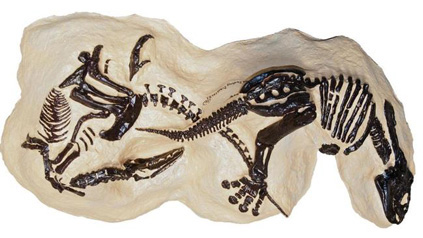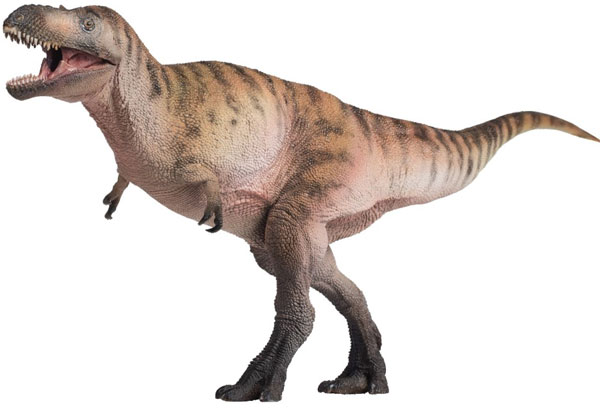“Duelling Dinosaurs” Up for Auction – Remarkable Fossils Up for Sale
Tyrannosaurid and Ceratopsian Fossils Heading for Auction
Two fossils found in association with each other in sediments from the famous Hell Creek Formation of Montana seem destined to go up for auction next November. The debate has once again sprung up between those who support commercial fossil hunters and those who believe that such discoveries should be made as a gift to science.
Dinosaurs Up For Auction
The fossils consist of a tyrannosaurid, billed in the press releases sent out regarding the proposed auction, as an example of a Nanotyrannus lancensis and a horned dinosaur, a member of the chasmosaurine clade of ceratopsians and possibly a new species. The two specimens have been referred to as “Montana’s Duelling Dinosaurs”. It has been suggested that these specimens represent a fight between a meat-eating and a plant-eating dinosaur. Although, team members at Everything Dinosaur have only a limited knowledge of what material has been excavated so far, it is likely that the “duelling dinosaurs” hypothesis has been put forward as the specimens were found in close proximity and after an examination of some of the pathology identified on the fossil bones.
“Duelling Dinosaurs” Go Up for Sale
Picture credit: Bonhams
Duelling Dinosaurs
Very rarely has the fossil record preserved anything as dramatic as a fight between two vertebrate antagonists, in this case, an example of inter-specific interaction. It is difficult to comment further as to the validity of these claims as with an auction looming, such statements might be aimed at “whetting the appetites of potential buyers rather than accurately reflecting evidence from a preliminary study” as a spokesperson from Everything Dinosaur commented.
The very fact that a Nanotyrannus specimen might be available for sale is fascinating. If it ends up in the hands of a private collector and as a result, it remains unavailable for study, this will disappoint a great many palaeontologists as well as their museum directors. Nanotyrannus might be a dwarf version of Tyrannosaurus rex, however, it could also represent juvenile specimens of T. rex itself. Skull material discovered in the 1940s and originally described as a Gorgosaurus was re-examined in the 1980s and it was suggested that the specimen represented an adult animal, an example of a new species of pygmy tyrannosaur. The Nanotyrannus genus was erected, its validity or otherwise has been debated ever since.
Nanotyrannus
A detailed study of the Montana tyrannosaur material may help to resolve this debate. Many palaeontologists fear that if the specimen is sold at auction to a wealthy individual, then the chance to study the fossils may be lost. According to other sources tyrannosaurid teeth are embedded in the ceratopsians bones and there may also be skin impressions preserved. It has also been reported that the tyrannosaurid may be considerably larger than other specimens of the nomen dubium N. lancensis, with well informed American palaeontologists suggesting that the individual tyrannosaur may be about the size of another member of the tyrannosaur family – Albertosaurus.
A Replica of Nanotyrannus
The picture (above) shows the PNSO Nanotyrannus figure.
To view the range of PNSO prehistoric animal models and figures in stock at Everything Dinosaur: PNSO Dinosaur Models and Figures.
Duelling Dinosaurs
The two near complete skeletons were found by commercial fossil hunters on private land. In the United States, fossils found on privately owned land are the property of the land owners, no matter what the significance to science. In this case, the owners of the fossils in collaboration with the prospectors can put these rare objects up for sale to the highest bidder. It has been estimated that the two specimens sold together as a single auction lot could fetch as much as £5.8 million (GBP).
The sale is going to managed by Bonhams auction house in New York. The “city that never sleeps” may turn out to be an ill omen for the sellers, as in May 2012, the sale of another tyrannosaurid, this time a Tarbosaurus was stopped after it was alleged the fossil material had been illegally removed from Mongolia. The Tarbosaurus fossils were returned to Mongolia and a fossil dealer from Florida will be sentenced next month over his involvement in the importing of the Late Cretaceous fossils into the United States.
To read more about the Tarbosaurus auction: U.S. Officials Seize Tarbosaurus Skeleton.
To read more about the legal action that followed: Tarbosaurus Case – Florida Man Pleads Guilty.
Senior scientific advisor at the Dinosaur Discovery Museum and director of the Carthage Institute of Palaeontology (Wisconsin), Thomas Carr commented:
“This lines their pockets [commercial fossil hunters and the owners of private land] but hurts science.”
Fossils To Be Sold At Auction
Approaches to museums and other educational bodies have already been made, but it seems that none are willing or able to pay the asking price, so the next step is for the fossils to be sold at auction. Many fossil specimens, even mounted exhibits of dinosaurs are sold each year, but the sale of these two items for what might turn out to be a record amount is likely to attract a lot of media interest.
However, not everything sells at an auction, in 2008 a Triceratops skeleton went under the hammer but it failed to sell on the day of the auction.
To read more about the Triceratops sale: Triceratops Specimen for Auction.
If a wealthy individual purchases the auction lot, then all may not be lost. Many adopt a philanthropic attitude to their acquisitions and make them available for further study, thus helping palaeontologists to learn more about long extinct prehistoric animals. Unfortunately, there is no guarantee and many purchasers prefer to remain anonymous. However, we, at Everything Dinosaur urge those responsible for the sale and indeed any prospective buyers to permit the specimens to be part of a formal study programme. In this way, these specimens are not lost to science for good.
With the very high prices paid for fossils, especially dinosaur fossils, an entire industry has sprung up catering for the demand. Whilst many of the organisations involved are highly professional and ethical, there are less honest fossil hunters out there, poaching, thefts and smuggling of fossil material is big business. How big? Nobody actually knows.
Let us hope that the sentencing of the Florida fossil dealer convicted of making false statements on customs forms when importing the Tarbosaurus material will help deter unscrupulous commercial fossil hunters. However, given the huge rewards available and the lack of international efforts to curb the trade we think that these practices will continue.
The Benefits Of Commercial Fossil Collectors
There is another side to consider when examining the role of commercial collectors. Many excavate their discoveries with the utmost care and are extremely professional. Such companies and individuals have made significant contributions to the science of palaeontology and without their efforts many important specimens would never have been found and many more would not have been preserved, simply left to erode away as they are exposed to the elements. With the cutbacks on museum funding, the number of field expeditions that museums can undertake has been reduced and commercial companies have successfully “plugged the gap” helping to preserve a large number of specimens that otherwise would have been lost to science.
Peter Larson, one of the world’s most distinguished commercial fossil hunters and an authority on tyrannosaurs has stated that the bones are well-preserved and articulated, with some fossilised skin impressions present. He has suggested that teeth from a predatory dinosaur are embedded in the cervical vertebrae (neck bones), whilst the tyrannosaurs chest and skull bones show evidence of being crushed, perhaps from a kick from the massive ceratopsian.
Peter and his company, the Black Hills Institute of Geological Research based in South Dakota, have been involved in the project to excavate and prepare the fossil material since 2011. Peter went onto add:
“The fossils provide potential evidence for two new kinds of dinosaurs. They could settle long-running scientific debates over whether the pygmy tyrannosaur existed as a separate genus or was simply a juvenile T. rex, and whether it hunted as well as scavenged.”
We at Everything Dinosaur, hope that if the fossils are put up for sale at auction, then the buyer will be generous and permit the specimens to be studied by the scientific community. Such a gesture would no doubt provide lots of positive PR and perhaps establish a blueprint for other lots that may go to auction to replicate.



